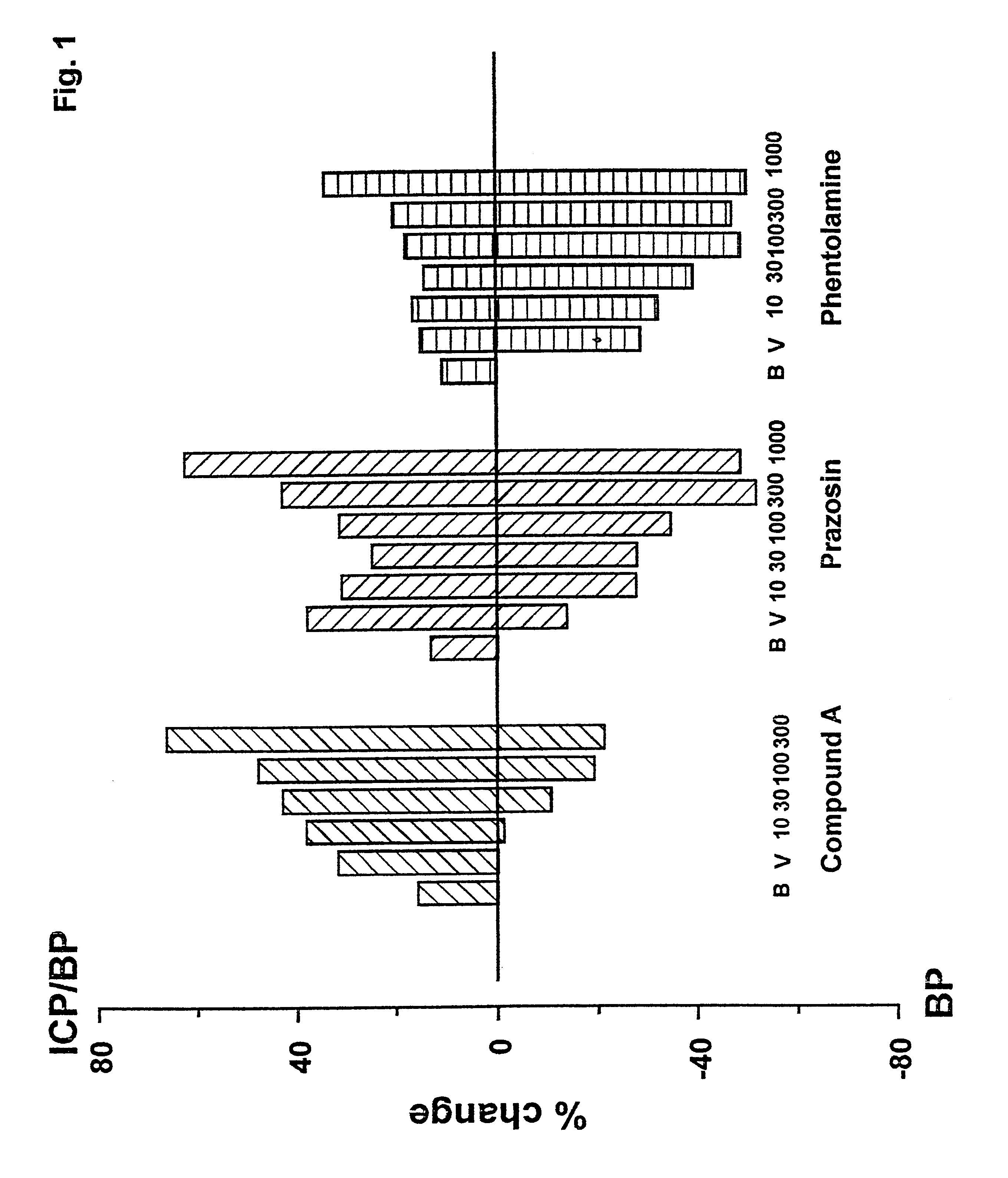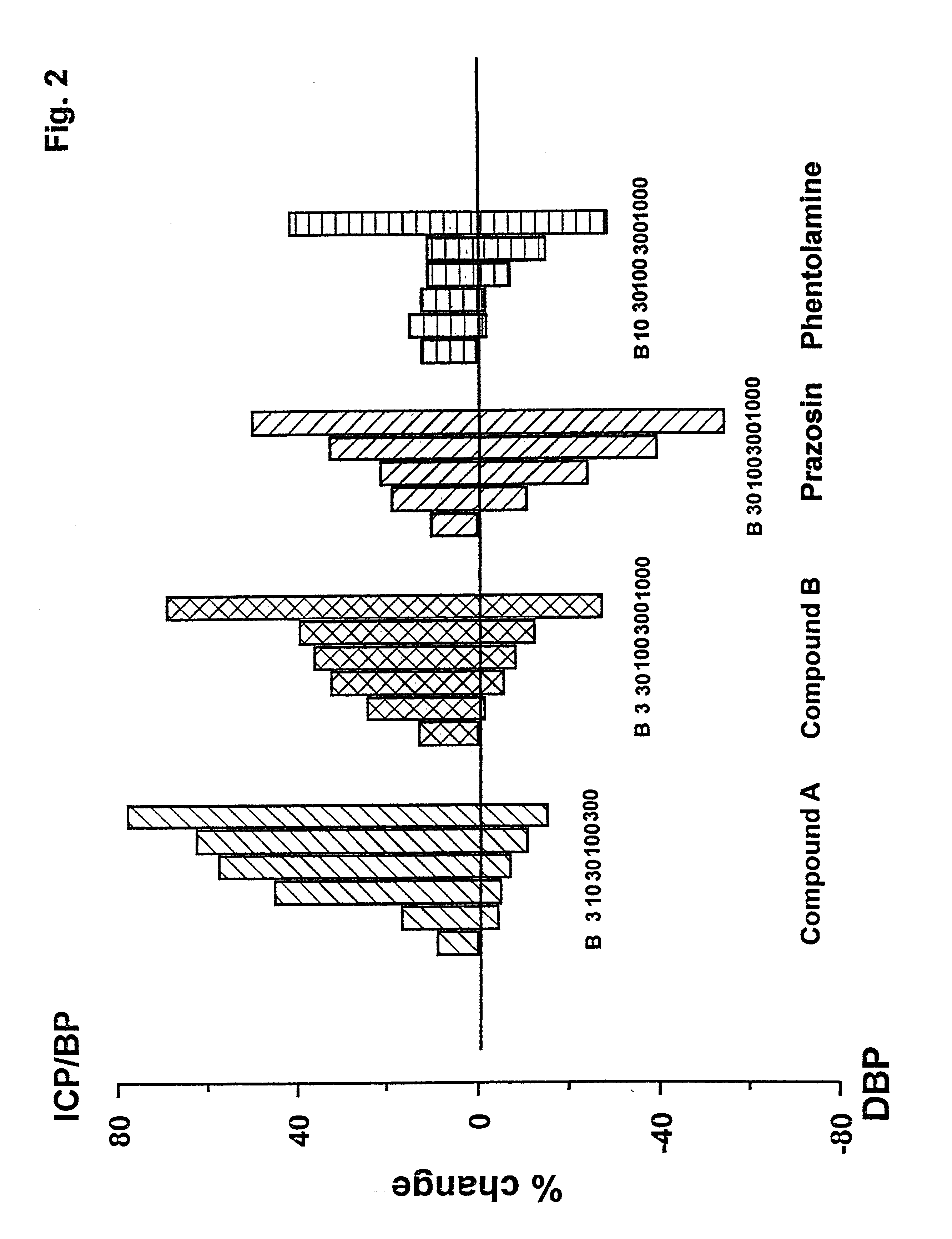Use of selective antagonists of the alpha1B-adrenergic receptor for improvement of sexual dysfunction
a technology of alpha1b-adrenergic receptor and selective antagonist, which is applied in the direction of elcosanoid active ingredients, instruments, drug compositions, etc., can solve the problems of inhibiting the flow of blood into the erectile tissue, inhibiting normal vaginal lubrication, and affecting the normal vaginal lubrication. , to achieve the effect of increasing the intracavernous pressur
- Summary
- Abstract
- Description
- Claims
- Application Information
AI Technical Summary
Benefits of technology
Problems solved by technology
Method used
Image
Examples
example 1
4-Amino-6,7-dimethoxy-2-[4-[(2-isopropyl-6-methoxyphenoxy)acetyl]-1-piperazinyl]quinazoline hydrochloride
(I: A=2-isopropyl-6-methoxyphenoxymethyl, B=B1) (Compound A)
2-Methoxy-6-isopropylphenoxyacetic Acid (Intermediate 1A)
[0110]A solution of 11.1 ml of ethyl bromoacetate in 10 ml of toluene was added dropwise at room temperature over about 15 minutes into a mixture of 20 g of NaOH, 30 ml of H2O, 1.1 g of triethylbenzylammonium chloride, 8.4 g of 2-isopropyl-6-methoxyphenol (prepared according to Johnson et al., Tetrahedron. 38, 1397-1404 (1982)) and 40 ml of toluene. The mixture was stirred vigorously at the same temperature for 2 h and thereafter for 2 h at 60-65° C. and for 6.5 h under reflux. During this last step a solution of 6 ml of ethyl bromoacetate in 10 ml of toluene was added. In the end the mixture was diluted with 250 ml of H2O. The aqueous phase was separated off and treated with concentrated HCl; the emulsified precipitate was extracted with Et2O (3×50 ml) and the org...
example 2
4-Amino-6,7-dimethoxy-2-[(4aR,8aS)-4-(2-furoyl)-cis-octahydro-1-quinoxalinyl]-quinazoline hydrochloride (I: A=(2-furyl), B=B3) (Compound B)
(±)-(2-furoyl)-cis-octahydroquinoxaline (2A)
[0112]1.44 g of 48% hydrobromic acid was added dropwise to a solution of 3.85 g of cis-octahydroquinoxaline (prepared as described in Brill et al., J. Org. Chem. 28, 1135-1138, (1963)) in 26 ml of ethanol and 4 ml of H2O stirred at 40-45° C. 1.16 g of 2-furoyl chloride was added dropwise over 15 minutes into the resulting solution and stirring was continued for 3 h at 80° C. The solution was concentrated to low volume, diluted with water and extracted with chloroform. The residue obtained after solvent evaporation was purified by flash chromatography eluting with petroleum ether: ethyl acetate: methanol: 28% aqueous ammonia 8:6:2:0.2 to give 2.35 g (40%) of the desired compound. M.p. 178° C. dec.
(+)-1-(2-furoyl)-cis-octahydroquinoxaline (2B)
[0113]A solution of 2.35 g of the above intermediate 2A in 22 m...
example 3
4-Amino-6,7-dimethoxy-2-[(3S)-3-(t-butylcarbamoyl)-4-(2-furoyl)-1-piperazinyl]-quinazoline (I: A=2-furyl, B=B2) (Compound C)
4-Amino-6,7-dimethoxy-2-r(3S)-3-(t-butylcarbamoyl)-1-piperazinyl]quinazoline (3A)
[0115]A mixture of 0.36 g of 4-amino-2-chloro-6,7-dimethoxyquinazoline, 1.08 g of (S)-N-tert-butyl-2-piperazinecarboxamide bis-(1 S)-(+)-10-camphorsulfonate, prepared as described in U.S. Pat. No. 5,700,364, and 0.94 ml of diisopropylethylamine in 10 ml of isoamyl alcohol was heated at reflux for 9 h. After cooling to room temperature, the solvent was evaporated in vacuo and 50 ml of dichloromethane was added to the residue. The mixture was washed with water (3×20 ml), 5% aqueous Na2CO3 (30 ml), water (3×20 ml), dried (Na2SO4) and evaporated to dryness. The residue was purified by flash chromatography eluting with chloroform: 2N methanolic ammonia 100:3 to give 0.173 g (30%) of the desired compound. 1H-NMR (CDCl3, δ): 1.35 (s, 9H, C(CH3)3), 1.65-2.10 (m, 1H, piperazine NH), 2.30-3....
PUM
| Property | Measurement | Unit |
|---|---|---|
| Molar density | aaaaa | aaaaa |
| Molar density | aaaaa | aaaaa |
| Molar density | aaaaa | aaaaa |
Abstract
Description
Claims
Application Information
 Login to View More
Login to View More - R&D
- Intellectual Property
- Life Sciences
- Materials
- Tech Scout
- Unparalleled Data Quality
- Higher Quality Content
- 60% Fewer Hallucinations
Browse by: Latest US Patents, China's latest patents, Technical Efficacy Thesaurus, Application Domain, Technology Topic, Popular Technical Reports.
© 2025 PatSnap. All rights reserved.Legal|Privacy policy|Modern Slavery Act Transparency Statement|Sitemap|About US| Contact US: help@patsnap.com



